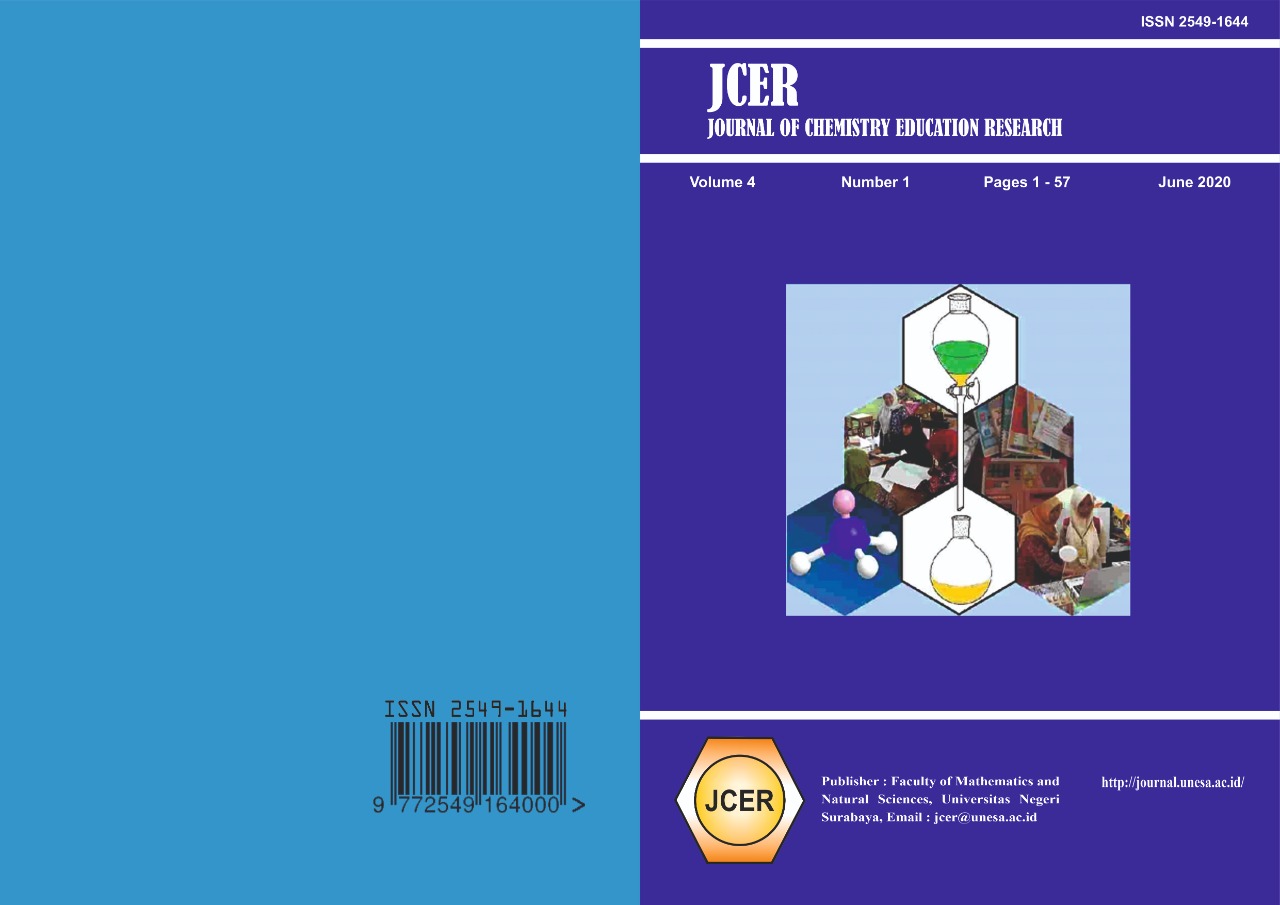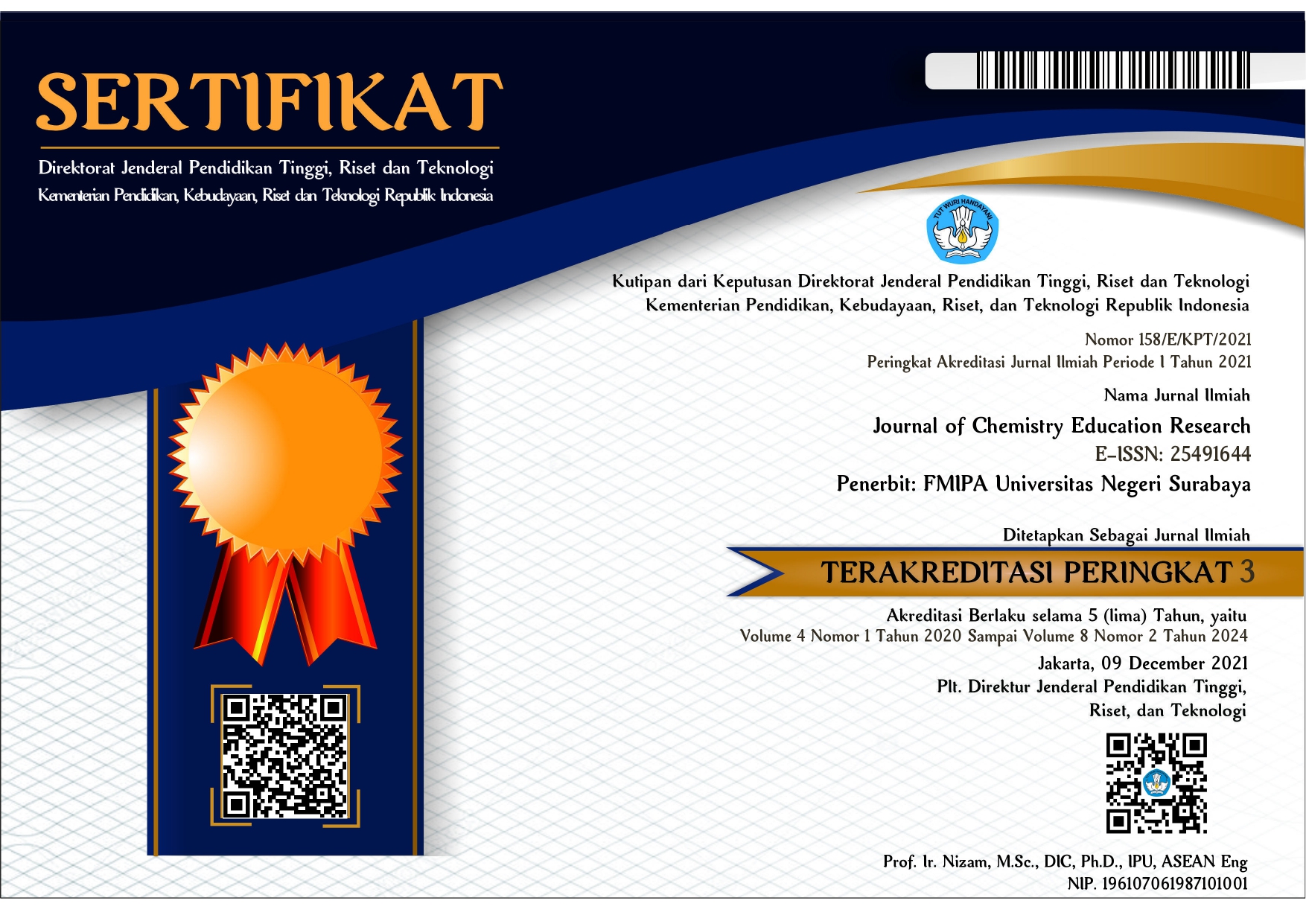TRAIN OF ABILITY OF CHEMISTRY TEACHERS TO MAKE OF HIGHER ORDER THINKING SKILLS LEARNING INDICATORS
DOI:
https://doi.org/10.26740/jcer.v4n1.p43-50Keywords:
berpikir tingkat tinggi, indicator ketercapaian hasil belajarAbstract
Based on the 2013 Curriculum (K-13), the ability to think at a higher level is an ability that must be possessed by every teacher, especially chemistry teachers. This study aims to determine the ability of teachers in compiling indicators of achievement of learning outcomes that require high order thinking skills. This research was conducted on Chemistry teachers who took part in professional education activities of teachers in positions ranging from batch 1 to 4, in 2019. There were 40 teachers who were subject of research in Chemistry. The results obtained are based on the results of testing about 2% of teachers who have been able to compile indicators of learning outcomes based on semi-high thinking (C3). Teachers after attending training above 97% are able to compile indicators of learning outcomes based on higher order thinking (C4). The increase in n-gains increases with a high category
References
[2] NRC. 2001. Inquiry and the National Science Education Standards. A Guide for Teaching and Learning, National Academy Press, Washington, DC. http://books.nap.edu/html/inquiry_addendum/ (2 of 2) [9/10/2001 3:37:45 PM] akses juli 2015.
[3] Sudrajad, Ahmad. 2013. Tantangan Guru Dalam Dunia Pendidikan dan Gambaran Pendidikan dalam Abad 21, http://akhmadsudrajat.wordpress.com/2013/07/02/ paradigma-pendidikan-indonesia-abad-ke-2. Akses Mei 2014
[4] Hammann, Lynne A. 2012. How To Promote Higher-Order Thinking In The Classroom: Reflecting And Writing, Not Reciting And Reacting (with Reflection Questions). http://www.unco.edu/cetl/ sir/stating_outcome/documents/Krathwohl.pdf. akses. 2015.
[5] Widana I Wayan. 2017. Modul Higher Order Thinking Skills (HOTS). Direktorat Pembinaan SMA Direktorat Jenderal Pendidikan Dasar dan Menengah. Departemen Pendidikan dan Kebudayan. Jakarta.
[6] Harris Iskandar. 2015. Penyusunan Soal Higher Order Thinking Skills. Direktorat Jenderal Pendidikan Dasar dan Menengah. Departemen Pendidikan dan Kebudayan. Jakarta.
[7] Sarquis, A. M.; Taylor, B. A. P. 1991, Improving Physical Science Instruction in Elementary Classrooms; School. Science Curriculum Conference; Co-Directors; American Chemical Society: Washington, DC,
[8] Gabel Dorothy. 1999. Improving Teaching and Learning through Chemistry Education Research: A Look to the Future. Journal of Chemical Education 76 (4), 548-553.
[9] Adlaon, R. B. 2012. Assessing effectiveness of concept map as instructional tool in high school Biology. (Unpublished Masters dissertation in Natural Sciences), Louisiana State University and Agricultural and Mechanical College, Baton Rouge, Louisians.
[10] Barbara Šketa., & Saša Aleksij Glažarb. 2005. Using Concept Maps in Teaching Organic Chemical Reactions. J. Acta Chim. Slov. 2005, 52, 471477.
[11] Ismono. 2015. Penggunaan Pembelajaran Berbasis Peta Konsep dalam Meningkatkan Proses dan Hasil Belajar Mahasiswa Pendidikan Kimia FMIPA Unesa pada Materi Pokok Isomer, Prosiding Seminar Nasional Kimia. ISBN : 978-602-0951-00-8, 3 Oktober 2015.
[12] Ismono., Sri Poedjiatoeti., Suyatno. 2016. Pengembangan model pembelajaran peta konsep berbasis inkuiri untuk melatihkan berpikir tingkat tinggi mahasiswa pendidikan kimia pada materi pokok isomer. Proseding seminar pendidikan IPA UM Malang. Vol 1. 2016. ISBN. 978-602-9286-21-2. pasca.um.ac.id/wp-content/uploads/2017/02/Ismono-639-651.pdf.
[13] Munzenmaier, C., and Rubin, N. 2013. Perpectives, Blooms Taxonomy: Whats Old is New Again. Learning Guild Research. http://educationalelearningresources.yolasite.com/ resources/guidresearchbloom2013% 1320(1).pdf. Akses Oktober 2014.
[14] Anderson, L. W. & Krathwohl, D. R. 2001. A taxonomy for learning, teaching and assessing: A revision of Blooms taxonomy of educational objectives. New York: Longman.
[15] King F.J., Ludwika G., & Faranak R., 2012. Higher Order Thinking Skills. Educational Service Program Publisher.
[16] Klingner, J., Vaughn, S., Dimino, J., Schumm, J., & Bryant, D. 2001. From clunk to click: Collaborative Strategic Reading. Longmont, CO: Sopris West.
[17] Slavin, R. E. 2008. Cooperative learning, success for all, and evidence-based reform in education. In É ducation et didactique, vol 2/2008, 149-157.
[18] Slavin, R. E. 2010. Co-operative learning: what makes group work? In H. Dumont, Istance, & F. Benavides (Eds.), The Nature of Learning: Using Research to Inspire Practice (pp. 161178). Paris: OECD.
[19] Lewis, A., & Smith, D. 1993. Defining higher order thinking. Theory into Practice, 32 (3), 131-137.
[20] Limbach, B., & Waugh, W. 2010. Developing Higher Level Thinking. Journal of Instructional Pedagogies. p: 1-9.
[21] Gagne, R.; Briggs, L.; Wager, W. 1988. Principles of Instructional Design. 4th Edition. ISBN 0-03-034757-2. https://www.scribd.com/document/323 442622/Gagne-R-Briggs-L-Wager-W-Principles-of-Instructional-Design. Akses Oktober 2015.
[22] McDavitt, David S. 1994. Teaching for Understanding: Attaining Higher Order Learning and Increased Achievement through Experiential Instruction. Non journal. ERIC Number: ED374093.
[23] Piaget, J. 1994. Cognitive Development in children: Piaget Development and Learning, J.Res. in Sci. Teaching, 1964, 2:176-186.
[24] Hake, R.R. 1998. Interactive-engagement vs traditional methods: A six-thousand-student survey of mechanics test data for introductory physics courses. Am. J. Phys. 66(1):64-74; also at < http://www.physics.indiana.edu/~sdi.
Downloads
Published
Issue
Section
License
Authors who publish with this journal agree to the following terms:
- Authors retain copyright and grant the journal right of first publication with the work simultaneously licensed under a Creative Commons Attribution License that allows others to share the work with an acknowledgement of the work's authorship and initial publication in this journal.
- Authors are able to enter into separate, additional contractual arrangements for the non-exclusive distribution of the journal's published version of the work (e.g., post it to an institutional repository or publish it in a book), with an acknowledgement of its initial publication in this journal.
 Abstract views: 323
,
Abstract views: 323
, PDF Downloads: 357
PDF Downloads: 357



